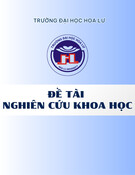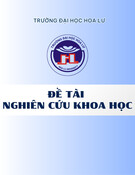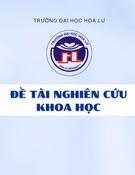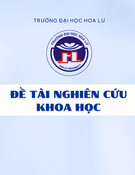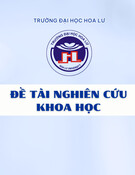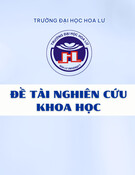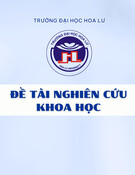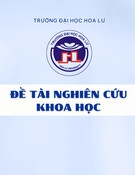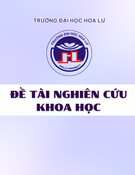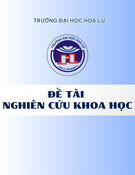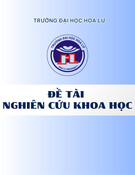
245
JOURNAL OF SCIENCE, Hue University, N0 61, 2010
POTENTIAL DEVELOPMENT IN SYSTEM MANAGEMENT, OPERATION
AND MAINTENANCE OF VILLAGE GROUND WATER SUPPLY SYSTEM
IN HUAI SAM MOR WATERSHED, KHON KAEN PROVINCE
Chatchawal Kiratiworasakun, Warangkana Sunsitthisawad
Faculty of Public Health, KhonKaen University
Kiksanachai Ruangjab
Water Resources Regional Office 4, Khon Kaen
SUMMARY
In the Huai Sam Mor Watershed, Khon Kaen Province, there are 15 village ground
water supply systems. Recently, only 8 of these systems have kept operating at Sub Somboon
Sub-district, Khoke Pho Chai District, Khon Kaen Province. This survey of village ground water
supply found that the administrative committees and the system operator had never been trained
in water supply management. There was also a lack of system maintenance, lack of daily system
monitoring, no washing of the filter and tower tank as a designated program, a lack of adjusting
the water pressure, and no chlorination before distribution. The major activities of this research
required by the village water supply management committees are to develop the potential
capacity on water supply management by practical training. Being practically trained would
provide knowledge about operation and maintenance of ground water supply management to
the village water supply management committees. After two months of the development training,
an improvement in the water supply system was reported as indicated by cleanliness of the
water supply system area, water pump checking, adjusting the water pressure according to the
tower tanks’ height, and cleaning filter tanks. However, schedules for regular and continuous
performance still relies on the village water supply management committee’s awareness to
maintain good water quality within the water supply system.
Keywords: potential development, village ground water supply system, village water
supply management committee.
1. Introduction
In Huai Sam Mor Watershed, Khon Kaen Province, there are 15 village ground
water supply systems. 13 of them are located in Khoke Pho Chai District, and other two
systems are in Manchakiri District. In Khoke Pho Chai District, there are two village
ground water supply systems in Pho Chai Sub-district and 11 in Sub Somboon Sub-
district. However the village ground water supply systems have encountered the
problem of raw water shortage. Currently, only eight systems are in operation, which

246
are in Sub Somboon Sub-district, which was the focus for this study.
Five village ground water supply systems were constructed based on the design
of the Groundwater division, Department of Mineral Resources (Former), and Ministry
of Industry. Three systems were constructed based on the design of the Water Supply
Division, Public Works Department (Former), and Ministry of the Interior. Afterwards,
they are to been turned over to be under the responsibility of the village water supply
management committees. The Sub Somboon Sub-district Administrative Organization
has been providing the academic knowledge for system operation and maintenance.
There have been several problems regarding the ground water supply
management of these eight ground water supply systems. The reason seemed to be the
turn over of the village administrative committees, village headman, and maintenance
personnel. Especially, most of the operators had never undergone training on how to
operate and maintain the ground water supply system. Lack of maintenance has caused
a shortening of the life span of the groundwater supply system. It was found the
operator did not clean the filter as well as the tower tanks as per the cleaning schedule.
Also, there was neither daily monitoring nor adjusting of water pressure. Besides, the
electricity for water pumping and chlorine use are high. When the electricity cost could
not be reduced, chlorine usage is then reduced instead. As a result, the biological
quality of the treated ground water could not pass the standard of drinking ground water
(Ministry of Industry, 2542). Moreover, there is a drought problem during the dry
season. The amount of ground water being pumped is low, which caused low water
pressure in the water pipes. The water demand is getting higher, but the water supply is
not adequate. In addition, the ground water containing limestone or high hardness
causes a blockage in the water pipes. Water supply distribution in some areas has to be
rearranged by setting a schedule time, which causes inconvenience to the water users.
The village ground water supply system, Sub Somboon Sub-district, Khoke Pho
Chai District, Khon Kaen Province, had been faced with the problem of water supply
management (Somkid Singsong, 2552). In order to improve the village water supply
system to produce clean tap- water safe for consumption, requires an efficient system of
management. The research for the potential development is necessary in order to find a
way to improve the village groundwater supply system management including operation
and maintenance systems. All of which are the fundamental public utilities that are
required for improving quality of life.
Objectives
This research aims to study the operation and maintenance of village ground
water supply systems which are operated by the village water supply management
committee, and to study the means of potential development of system management,
operation and maintenance..

247
Scope of Research
1. Conduct the potential development of village groundwater supply system by
discussing the requirements of the village water supply management committees in all
eight places. This is to improve the operation and maintenance system according to the
designed schedule that would further improve the water quality to a certain level.
2. Study the village water supply system focusing on the ground water supply
system, which was turned over from the Department of Mineral Resources, Ministry of
Industry, and the Regional Water Work, Public Works Department, Ministry of Interior;
to Sub Somboon Sub-district Administrative Organization, Khoke Pho Chai District,
Khon Kaen Province.
3. Data collection was divided into 2 phases: 1) before taking actions, and 2) 2
months after solving the problems of water supply system
4. Use the study of Tap Water Quality and Satisfaction of Water Users of
Village Ground Water Supply in Huai Sam Mor Basin, Khon Kaen Province
(Warangkana, Chatchawal, and Kiksanachai, 2552) to detect whether any water quality
parameters of the referred study were below the Standard of Drinking Water Quality of
Deep Wells (Ministry of Industry, 2542), water samples were collected and analysed for
such water quality parameters after 2 months implementation of the development
process.
2. Methodology
2.1.The research pattern is Action Research
2.2.The study population was divided into 3 groups as follows
2.1.1. Eight village ground water supply systems, in Huai Sam Mor Watershed,
Khoke Pho Chai District, Khon Kaen Province, which have been turned over to the
village water supply management committees and Sub-district Administrative
Organizations, located in 7 villages: Nhong Ya Plong, Sub Dang, Sub Bon, Non Sawang,
Sub Somboon, and Sub Charearn, as shown in Table 1 and Figure 1.
2.1.2. The village water supply management committees, as the village
representatives who manage the village water supply system. The total is 28 peoples
consisting of chairman, secretary, treasurer, and other members.
2.1.3. The water supply operators were the representatives of the villages,
whose job description is managing, operating, monitoring, and maintaining the water
supply system to provide consistency in water supply production.
2.3. The research tools were divided into 3 parts as follows:
2.3.1. A checklist was used for surveying the environmental condition and
completeness of the structure of water supply system as well as the actual performance

248
of the operator.
2.3.2. A questionnaire for interviewing the village water supply management
committees consisted of 2 parts. 1) General data of the village water supply
management committees including the duration of holding the post, how to achieve the
current post holding, other duties in the village, and training to manage the village
water supply system, etc. 2) The performance status in human resources, finance,
materials, and management.
2.3.3. A questionnaire for interviewing the village water supply operators
comprising of 3 parts. 1) General data about the operator including duration of the
holding the post, how they came to hold the current post, other duties in the village, and
the training to manage the village water supply system, etc. 2) Operational data of
building systems according to the maintenance schedule, which is modified from the
operation assessment according to the maintenance schedule of Water Resource
Department (2549). 3) An open-end questionnaire for the maintenance problems in
water supply system.
2.4. Procedure
2.4.1. The purpose of the research (November, 2551) was stated during a
monthly meeting for the Sub Somboon Sub-district Administrative Organization and
cooperation in the research from the community leader, the water supply management
committees was requested.
2.4.2. The problems in the operation of village water supply systems from the
operators point of view were studied by using checklists and direct interviews.
2.4.3. The problems in management were studied by interviewing the village
water supply management committees about the management and operation process.
2.4.4. The groundwater quality criteria of the project entitled “ Tap Water
Quality and Satisfaction of Water Users to village Ground Water Supply in Huai
Sam Mor Basin, Khon Kaen Province (Warangkana, Chatchawal, and Kiksanachai,
2552) was used as the fundamental water quality data of this research for determining a
potential development process
2.4.5. A focus group was performed in order to ascertain the means of potential
development.
2.4.6. Assignments for village water supply systems such as; problem
assessments, missed- performance of the operator, management of the village water
supply management committees, and water quality problems were designated. A part of
the water quality problems might be from the mal-function of the water treatment
process and periodic maintenance, e.g., backwash of sand filters and the cleanliness
around the water supply system areas.

249
2.4.7. Informed, followed up, and evaluated the assignment and responsibilities.
The assignment evaluation was made by interviewing the operator group, and village
water supply management committees based on the structured questionnaire.
Examination of water quality for the problematic parameters relevant to the water
supply process as well as operational obstacles were undertaken by collecting the data
after 2 months of group meetings, which were in February, 2552.
2.4.8. Water quality between before and after the potential development process
was compared. Water quality was improved after implementation of potential
development process, e.g. iron and coliform bacteria.
2.5. Data analysis was performed by using descriptive statistics such as
percentages, averages, and standard deviations. Knowledge in water supply systems
were analysed using T-Tests to test the difference between averages before and after the
training.
3. Results
3.1. Village ground water supply systems before the implementation of
potential development
3.1.1. Maintenance status
The village water supply system operated by the village water supply
management committees, under the responsibility of Sub Somboon Sub-district
Administrative Organization, Khoke Pho Chai District, is the small scale of deep water
supply, which has an angle-corner-shape of equal-side pentagon. This design is
according to the former pattern of the Department of Mineral Resources (former),
Ministry of Industry, and Water Supply Division, Public Works Department (former),
Ministry of the Interior. The village water supply system started with pumping
groundwater from a deep well to the aeration unit, where dissolved iron and manganese
are precipitated. Then the water is pumped to be stored in the tower storage tank of 12
cubic meters in capacity. The water is distributed using the pressure from the tower
storage tank through iron and manganese filter tank, without chlorine addition, into the
distribution line to the consumers via water meter.
Before implementation of potential development, the condition of the village
groundwater supply system of 8 places was noted as follows. There was no sign
indicating animal raising was prohibited in the area. Almost all water supply systems
distribute water for a whole day except one place distributes water only morning to
evening due to insufficient water. Half of the water supply systems (4 places) had not
been cleaned around the area of deep well, tower tank, filter tank, and were covered
with overgrown grass and garbage. All deep wells were equipped with PVC pipes. Two
deep wells ‘PVC pipes were covered with weeds and garbage. All water supply systems

